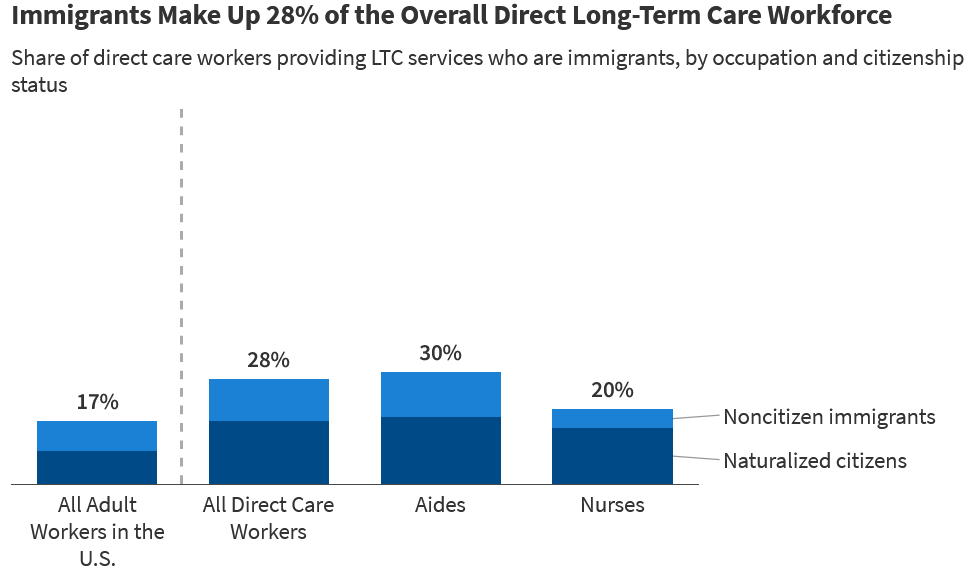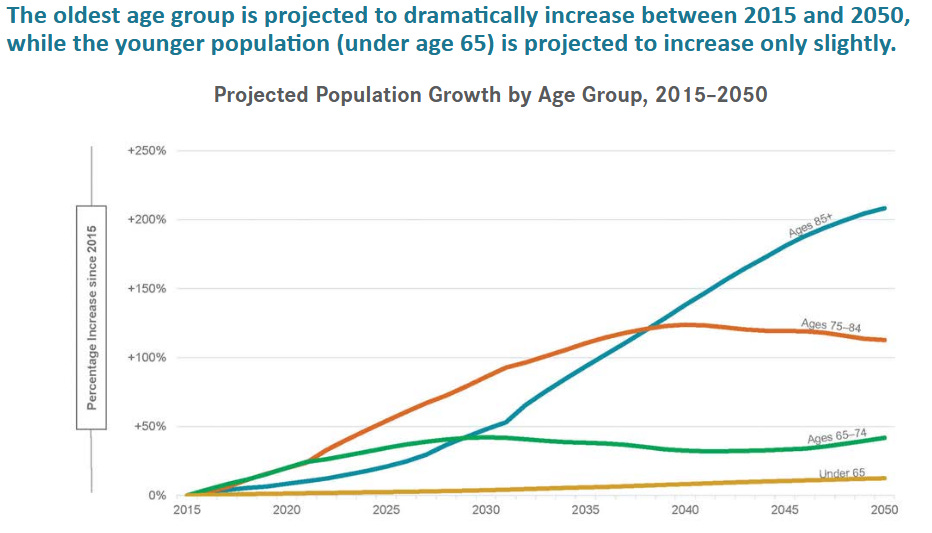With Americans having fewer children and the baby boomer cohort rapidly retiring, it has been immigrants — both documented and undocumented — who have been shoring up the U.S. workforce. Immigration has been vital to the U.S. economy as from 2000 to 2022 the number of U.S.-born residents in the prime working age — 25 to 64 — has not changed, while the 65 and over population grew by 18 million. During the same years, the number of prime-working-age immigrants grew by 7 million.
The Elder Care Workforce
Immigrants have become especially important in the fields of health care in general and elder care in particular. One study found that in 2017 immigrants accounted for 18% of all health care workers, 23.5% of long-term care employees, and 27.5% of direct care workers, although they made up just 15.5% of the total U.S. population. According to another report, in 2021 there were approximately 560,000 people working as home health aides in the United States, of whom 40% were immigrants, and about 1.5 million nursing assistants, 28% of whom were immigrants.
Other researchers report different numbers, but they all describe a high proportion of immigrant workers in the elder care field. According to KFF, immigrants make up 28% of the overall direct care workforce for LTC services and 32% of home care workers.
Limiting Immigration
As this chart shows, most of these workers are naturalized citizens. But many are noncitizens, a large number of whom will soon lose their authorization to work as President Trump ends their protected status over the next several months. There are about 4 million immigrants with limited status, including 2 million asylum applicants, 560,000 DACA holders, 650,000 with temporary protected status (including those from Haiti and Venezuela) and 520,000 with grants of parole (including immigrants from Afghanistan and Ukraine).
All of the figures above describe immgrants with legal status. Immgrants without documentation also play a significant role in providing elder care. There are approximately 13.7 million unauthorized immigrants in the United States. Approximately 346,000 work as health care providers of whom an “estimated 142,000 undocumented immigrants serve as childcare workers, personal care aides, and home health aides.” While, according to reports, undocumented immigrants are afraid to go to work during the current immigration crackdown, most still do so since they need to support themselves and their families.
Morgan Stanley has predicted that net immigration to the United States will fall from 2.7 million in 2024 to 1 million in 2025 and 500,000 in 2026.
Just When We Need More Elder Care Workers
Limiting the number of potential care workers comes at a critical time as the baby boomers age. The oldest baby boomers will reach age 85, when the likelihood of needing assistance increased dramatically, in just six years. According to the National Academy of Social Insurance, “The rise in the aging population will increase the number of people needing LTSS [long-term services and supports]. By 2050, the 85 or older population will more than triple (growing by 208 percent), while the population younger than 65 will increase by only 12 percent. The number of seniors needing LTSS is expected to rise from 6.3 million in 2015 to an estimated 15 million by 2050.”
They predicted a shortfall of 355,000 paid care workers by 2040 before the current crackdown on immigration began. The Bureau of Labor Statistics predicts that home health and personal care aides will be the fastest growing job category from 2023 to 2033, and that’s before the need will really begin to grow. As this chart shows, the 65 to 74 age group has already reached its peak and the number of 75 to 84 year olds will stop expanding in the mid-2030s. In contrast, the 85 and older cohort, who are much more likely to need elder care than younger seniors, will keep growing through 2050 by which time their numbers will have tripled since 2015.
In short, just as we need more people willing to take on the grueling job of providing hands-on care to those who cannot care for themselves, the Trump administration is making it more difficult for many of those who would provide such care to come to the United States or for those already here to stay in the workforce.





Robotics related to elder care and healthcare will be a big market. Probably feasible and needs support for related basic research. Similar capabilities will also benefit agricultural robotics.